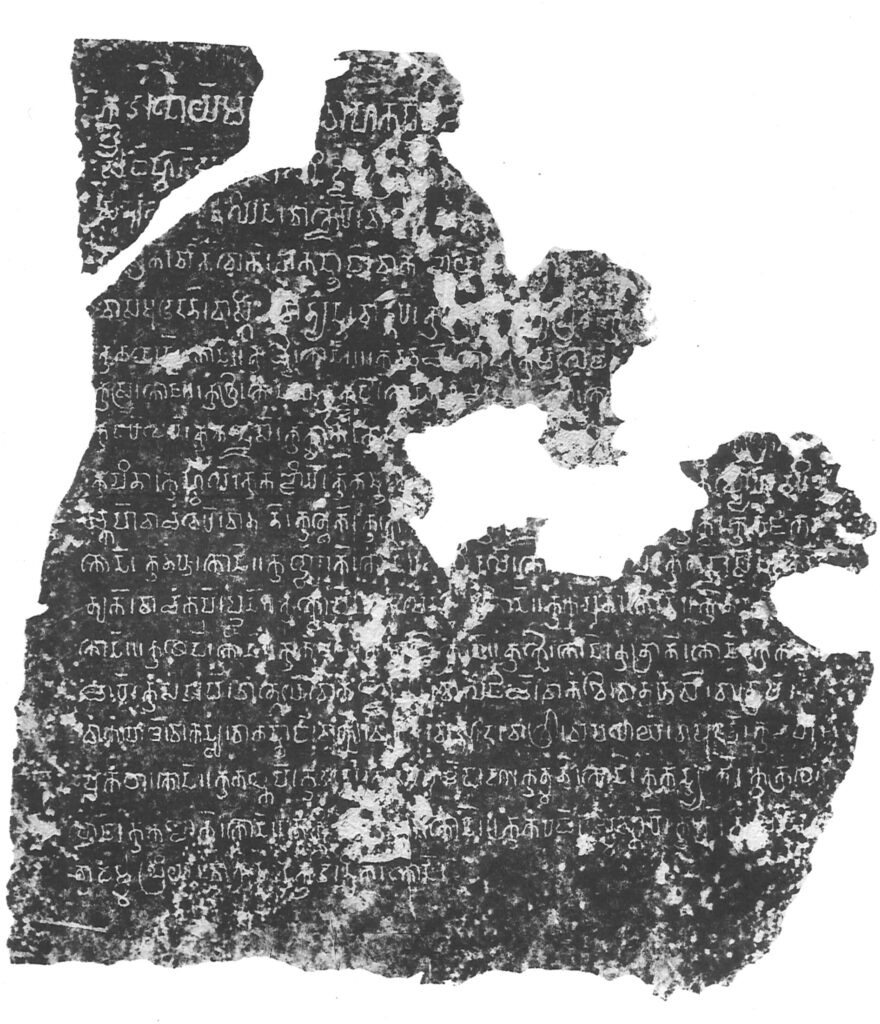កាលដើមឡើយសិលាចារឹកមួយផ្ទាំងនេះ អ្នកស្រាវជ្រាវពុំស្គាល់ប្រភពច្បាស់លាស់ ថាមកពីទីតាំងដើមណាមួយនោះទេ។ តាមរបាយការណ៍ក្នុងឆ្នាំ១៩១៤គេដឹងថាវាជាផ្ទាំងសិលាចារឹកដែលលោក អាដេរម៉ា ឡឺក្លែរ យកមកជាមួយសិលាចារឹកលេខ K.១៣៣ និង K.១៣៤ ទុកនៅសារមន្ទីរអាល់ប៊ែរសារូត៍ បច្ចុប្បន្នគឺសារមន្ទីរជាតិភ្នំពេញ។ បន្ទាប់មកសិលាចារឹកនេះបានយកទៅរក្សាទុកនៅអភិរក្សដ្ឋានអង្គរ។ ក្រោយមក ទើបគេដឹងថា ផ្ទាំងសិលាចារឹកនេះមានប្រភពចេញមកពីទួលកំណប់ត្រពាំងថ្ម ដែលមានទីតាំងស្ថិតនៅភូមិដូនមាស ឃុំសំបូរ ស្រុកសំបូរ ខេត្តក្រចេះ។ កន្លងមក យើងបានចុះផ្សាយអត្ថបទសិលាចារឹកផ្ទាំងទី២ រួចមកហើយ ដែលលោកអ្នកអាចចូលអានតាមរយៈ៖ https://ams.com.kh/khmercivilization/detail/28234។
ថ្វីដ្បិតតែតាមឯកសារបញ្ជាក់ថាផ្ទាំងសិលាចារឹកនេះ មានប្រភពចេញមកពីទួលកំណប់ត្រពាំងថ្មី ដូចសិលាចារឹកមួយផ្ទាំងទៀតដែលចុះលេខ K.១៣៣-២ ក្ដី ក៏សិលាចារឹកទាំងពីរផ្ទាំងនេះ ពុំគួរជាសិលាចារឹកដែលទាក់ទងគ្នាឬតគ្នានោះទេ។ ពោលដូច្នេះ ដោយអាងទៅលើសេចក្ដីនៃអត្ថបទពុំទាក់ទងគ្នាឡើយ។ អ្វីដែលកាន់តែគួរឱ្យកត់សម្គាល់ទៀតនោះ គឺទម្រង់តួអក្សរសិលាចារឹកទាំងពីរផ្ទាំងនេះ ពុំដូចគ្នានោះទេ។ ដូច្នេះហើយ ពុំគួររាប់ថាហៅថាជាផ្ទាំង K.១៣៣-១ នោះទេ គួរតែហៅជា K.៤៨០ តែមួយបានហើយ។ ផ្ទាំងសិលាចារឹកនេះ បែរមានទម្រង់តួអក្សរដូចគ្នាទៅនឹងសិលាចារឹកត្រពាំងប្រី K.១២៧ សិលាចារឹកទួលកំណប់តាកឹង K.១២៩ និងសិលាចារឹកភ្នំសំបុក K.៤៣០ ទៅវិញ។
អត្ថបទចារឹកនេះ មានអក្សរចារឹកចំនួន១៨បន្ទាត់ ចារនៅលើផ្ទាំងថ្ម មានកម្ពស់១៦៥ស.ម. បន្ទារ៦៣ស.ម. និងកម្រាស់១៨ស.ម.។ សិលាចារឹកនេះពុំមានចុះកាលបរិច្ឆេទនោះទេ ប៉ុន្តែតាមការប្រៀបធៀបទម្រង់តួអក្សរ អាចឱ្យយើងដឹងថាស្ថិតនៅក្នុងចន្លោះស.វ.ទី៧និងស.វ.ទី៨។ ដោយផ្ទៃថ្មនេះ បាក់បែកខ្លះ ធ្វើឱ្យដាច់ដោចអត្ថបទដោយអន្លើ។ យ៉ាងនេះក្ដី យើងអាចសង្ខេបខ្លឹមសាររួមនៃអត្ថបទនេះបានថាជាបញ្ជីអ្នកបម្រើប្រុសស្រីដែលថ្វាយ ទៅទីតាំងប្រាសាទមួយដែលបានដាច់ឈ្មោះ និងទំនងជាថ្វាយដោយមហានៅវាហករ។

អត្ថបទដើមជាអក្សរខ្មែរទំនើប
១- ក្ញុំអំនោយ៑ម[[ហានៅ]]វាហករ[[ឰតវ្រះកម្រតាង៑អញ៑]]—-
២- សង៑ហ្វន៑អ—សនិទ្ធេ្រ———-
៣- វាត្យ—ារិឈិន១វាក្ទេរ៑១វា———-
៤- វាស្រត៑១វាកំវោក៑១វាកន្តាង៑១វាកញ្ជយ៑១——
៥- វាសមុទ្រទត៑១វាស្គិះ១វាត្យន១វាត្គរ៑១កុ—១កុប្រុ១កុ—
៦- កុកន្សេង៑១កោន៑២កុច្វៃ១កោន៑៤កុតំវច៑១កោន៑១កុមលេង៑១—
៧- កុស្រុ១កោន៑៣កុវ្រៃ១កោន៑៣កុក្ជុង៑១កោន៑១កុចប៑-១កុ–១កោ(ន៑)—
៨- កុងរ៑ងោរ៑១កុកន្ទេស៑១កុក្មាក៑១កុ———-
៩- កុបិតា១កុហ៌្វល៑១កុកញ្ជិរ៑១កុកន្តា-១កុ———កុ(ច្យោរ៑១កុរ)–
១០- ច្កហ៑វាចំវេរ៑១វាតត៑១កុត្វេក៑១កុកោ—-កុ———-កុ(ក្ទំ/ក្មំ)១កុសំជក៑១
១១- កោន៑១កុតំរូ១កោន៑២កុប្សោក៑១កោន៑២កុ–ល៑១កោ(ន៑)-កុ–ប៑១កុកន្ទាស៑១កុក–
១២- តុត៑១វាចំកប៑១ប្ឱន៑២កុក្វោប៑១កុ-លន–១កោន៑២កុកំបុត៑១កោន៑២កុតំន–(១)
១៣- កោន៑៣កុថេប៑១កោន៑២កុកំជក៑១កុ—១កោន៑២កុក្នៃ១កោន៑១កុត្រាក៑១កោន៑១កុក–
១៤- ចោរ៑១កុសំអប៑១វាត្គេល៑១វាកញ្ជោស៑១វាសំជាច៑១វាកំវៃ១វាតំរុស៑១វាត្រម៑១
១៥- វាកំបោញ៑១វាកន្សំ១វាកន្តាង៑១វាក្នៅ១វា–ត៑១វាអ្នាទ១វាវ្រៅ១វាបរោយ៑១វាសុំទត៑១កុចប៑១
១៦- ប្លេកថា១កោន៑២កុកប្កេប៑១កុអ(ប៑)១កុ-(លជា)ដាហ១កុត្មត៑១កោន៑១កុកន្ត្យក៑១កុក្រវេ១
១៧- បោង៑១កុកញ្ចេក៑១កោន៑២កុ(តិ)–១កុ—១កោន៑៣កុកំរង៑១អ្មេស្តារ៑១កុក្រំ១កុ—
១៨- វាធម៌្មប្រិយ១វាក(ន្លះ)១កុអន្លិក៑១កោន៑១
អត្ថបទប្រែសម្រួល
អ្នកបម្រើជាតង្វាយរបស់មហានៅវហករថ្វាយចំពោះព្រះ— (មានដូចជា) –សង្វន៑អអ—សនិទ្ធេ្រ———- វាត្យ—ារិឈិន១ វាក្ទេរ១ វា———- វាស្រត១ វាកំវោក១ វាកន្តាង១ វាកញ្ជយ១ —— វាសមុទ្រទត១ វាស្គិះ១ វាត្យន១ វាត្គរ១ កុ—១ កុប្រុ១ កុ— កុកន្សេង១ និងកូន២ កុច្វៃ១ និងកូន៤ កុតំវច១ និងកូន១ កុមលេង១— កុស្រុ១ និងកូន៣ កុវ្រៃ១ និងកូន៣ កុក្ជុង១ និងកូន១ កុចប-១ កុ–១ និងកូន— កុងរងោរ១ កុកន្ទេស១ កុក្មាក១ កុ-——— កុបិតា១ កុហ៌្វល១ កុកញ្ជិរ១ កុកន្តា-១ កុ——— កុច្យោរ១ កុរ– ច្កហ វាចំវេរ១ វាតត១ កុត្វេក១ កុកោ—-កុ———- កុក្ទំ១ កុសំជក១ និងកូន១ កុតំរូ១ និងកូន២ កុប្សោក១ និងកូន២ កុ–ល១ និងកូន កុ–ប១ កុកន្ទាស១ កុក–តុត១ វាចំកប១ និងប្អូន២នាក់ កុក្វោប១ កុ-លន–១ និងកូន២ កុកំបុត១ និងកូន២ កុតំន– និងកូន៣ កុថេប១ និងកូន២ កុកំជក១ កុ—១ និងកូន២ កុក្នៃ១ និងកូន១ កុត្រាក១ និងកូន១ កុក–ចោរ១ កុសំអប១ វាត្គេល១ វាកញ្ជោស១ វាសំជាច១ វាកំវៃ១ វាតំរុស១ វាត្រម១ វាកំបោញ១ វាកន្សំ១ វាកន្តាង១ វាក្នៅ១វា–ត១ វាអ្នាទ១ វាវ្រៅ១ វាបរោយ១ វាសុំទត១ កុចប១ ប្លេកថា១ និងកូន២ កុកប្កេប១ កុអ(ប៑)១ កុ-(លជា)ដាហ១ កុត្មត១ និងកូន១ កុកន្ត្យក១ កុក្រវេ១ បោង១ កុកញ្ចេក១ និងកូន២ កុ(តិ)–១ កុ—១ និងកូន៣ កុកំរង១ ម៉ែស្តារ១ កុក្រំ១ កុ— វាធម៌្មប្រិយ១ វាក(ន្លះ)១ កុអន្លិក១ និងកូន១។
——————–
Toul Kamnop Trapeang Thmor Inscription (K.480 or K.133-1)
The origin and provenance of the inscription K.480 have long remained a mystery, with previous research failing to provide definitive answers. However, recent discoveries and comparative analyses shed light on its intriguing background. This article aims to explore the historical context and significance of K.480, offering insights into its potential relationship with other inscriptions and its possible dating.
According to a 1914 report, K.480 was among a collection of Adhémard Leclère inscriptions, including K.133 and K.134, that were originally housed in the Albert Sarraut Museum, presently known as the National Museum. Subsequently, the inscription found its way to the Conservation of Angkor in Siem Reap, although the exact date of this transfer remains uncertain.
After extensive research, scholars have verified that K.480 corresponds to the inscription K.133-1, distinct from K.133-2. The inscription was retrieved from Toul Kamnop Trapeang Thmor, situated in Duan Meas village, Sambor Commune, Sambor District, and Kratie Province. Our article on K.133-2 can found on https://ams.com.kh/khmercivilization/detail/28234.
Importantly, it is crucial to note that while K.480 shares the same numerical registration as K.133-2, this does not imply a direct association or pairing between the two. This hypothesis is based on the examination of the inscription’s meaning and paleographic characteristics. Consequently, it is more appropriate to refer to this inscription as K.480 rather than K.133-1. Comparisons suggest that the script used in K.480 bears closer resemblance to K.127 from Trapeang Prei, K.129 from Ta King, and K.430 from Phnom Sambuk.
The inscription is meticulously carved on sandstone, spanning 18 lines. It measures 165 cm in height, 63 cm in width, and 18 cm in depth. Regrettably, the absence of a specific date within the inscription complicates its precise dating. However, based on paleographic comparisons, it is reasonable to attribute its creation to the 7th-8th century. Notably, the presence of fragmented portions on the stone’s surface has resulted in some loss of script. Although undated, the inscription primarily comprises a list of temple servants, presumably donated by Mahanauvāhakara.
The enigmatic inscription K.480 has intrigued researchers for years, with its origin and significance veiled in uncertainty. Recent investigations have enabled the identification of its source and offered valuable comparative insights. By understanding its potential associations with other inscriptions and employing paleographic analysis, we can place K.480 within the broader historical context of the 7th-8th century. While the inscription’s exact purpose and significance may continue to elude us, its exploration contributes to our knowledge of ancient cultures and their religious practices.
អត្ថបទដោយ៖ លោក ហ៊ុន ឈុនតេង






